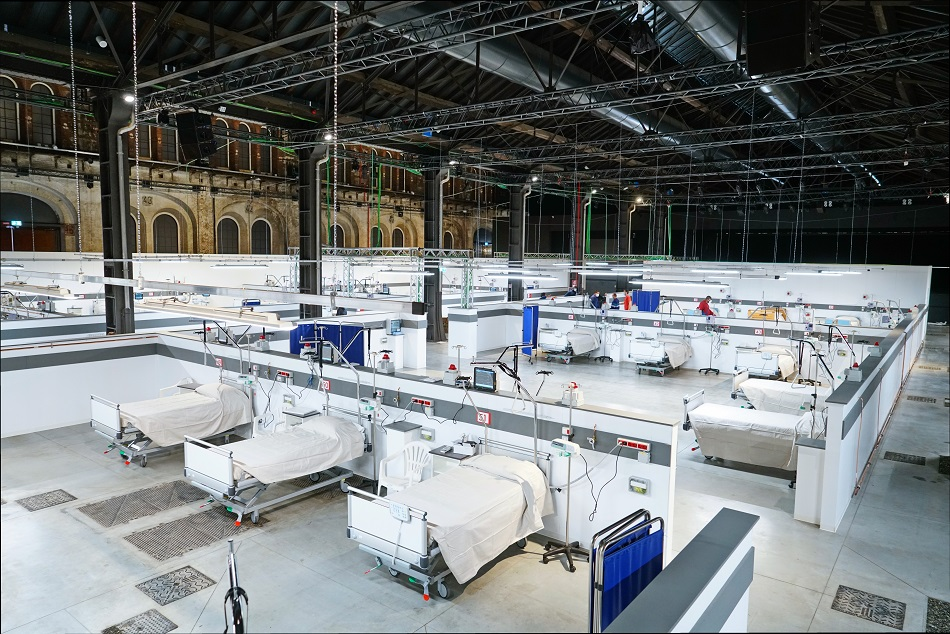The use of mechanical ventilators can lead to elevated oxygen levels in hospital wards, leading to a potentially major fire hazard. Throughout the current COVID-19 pandemic, reliance on ventilators has increased, which in turn has intensified the risk of dangerous oxygen enrichment on hospital wards.

Image Credit: MikeDotta/Shutterstock.com
International Gas Detectors was called upon to supply the NHS with rapid-response gas detection solutions to secure COVID-19 wards and make them safe concerning oxygen hazards.
During the initial stages of the pandemic, the use of ventilators in hospitals quickly expanded as between 5-15% of COVID-19 patients require ventilatory support.1 Ventilation offers additional oxygen to tackle hypoxemia (decreased oxygen in the bloodstream), and pressurized delivery of air or oxygen (e.g. in the administration of Continuous Positive Airway Pressure (CPAP)) can further aid the physical process of breathing.2
Ventilation is a vital therapeutic treatment where COVID-19 is concerned and has clearly improved patient outcomes throughout the current Coronavirus pandemic. However, a surge in the use of ventilators comes with its risks: oxygen leaks from tubes, canisters, and masks can lead to environments with enriched oxygen levels.
While technically speaking oxygen itself is not flammable, it is an oxidizing agent that can create or assist the ignition and combustion of other materials.
Consequently, anything residing within an atmosphere where oxygen levels are higher than normal is at a heightened risk of catching fire.
Unfortunately, these risks are not hypothetical situations for hospitals. In 2008, a fire in London’s Great Ormond Street Hospital led to an oxygen cylinder explosion – thankfully, nobody was harmed.3 NHS guidance published in March calls attention to the elevated oxygen enrichment hazard due to increasing ventilator use throughout the current COVID-19 pandemic.4
Ventilators don’t need to be defective or malfunctioning to leak – oxygen can find its way out of a ventilator system at various points when in use. In effect, mask ventilators have a degree of permissible leakage to enable patient exhalation. Even ventilation delivered via tracheal intubation – regarded as a “closed” system – has some degree of leakage.
The only surefire way to establish if oxygen levels are meeting safety limits is the installation of reliable and accurate gas detectors.
Throughout the current COVID-19 outbreak, International Gas Detectors has supplied several NHS facilities with oxygen detection solutions. Initially, the requirement was to offer an oxygen-detection solution that could be quickly installed on the wards of existing hospitals that were receiving more and more COVID-19 patients. Simple-to-use standalone units such as the TOCSIN 625 and 640 were accordingly provided. Moreover, it was necessary that these units were straightforward to install and set-up. Therefore, the wall-mountable units were pre-calibrated and shipped with simple-to-use instructions so that hospital staff could simply fit the units themselves.
Following on from previous requirements, the next demand was to provide an interconnected gas detection system in order to link the temporary NHS Nightingale hospitals constructed around the country in response to the pandemic. In the case of these systems, local gas detectors were networked back to a control panel at the nursing facility, this enabled central control of the alarms and the management of any issues from that area. 2-Wire addressable technology facilitates the interconnection of 32 devices on a single cable, therefore ensuring the system could be rapidly implemented at a low cost.
References and Further Reading
- Möhlenkamp, S. & Thiele, H. Ventilation of COVID-19 patients in intensive care units. Herz 45, 329–331 (2020).
- Modes of Mechanical Ventilation. Available at: https://www.openanesthesia.org/modes_of_mechanical_ventilation/. (Accessed: 22nd July 2020)
- Director, M. R. Workshop 2012-Oxygen Safety Oxygen Fires in Healthcare Facilities Workshop 2012-Oxygen Safety 2 Contents Introduction What can happen when it goes wrong Typical timelines for an incident Lessons learnt from incidents Risk Assessment and Training Conclusions.
- Hospitals warned of increased fire risk on covid-19 wards | News | Health Service Journal. Available at: https://www.hsj.co.uk/patient-safety/hospitals-warned-of-increased-fire-risk-on-covid-19-wards/7027227.article (Accessed: 22nd July 2020)

This information has been sourced, reviewed and adapted from materials provided by International Gas Detectors Ltd.
For more information on this source, please visit International Gas Detectors Ltd.